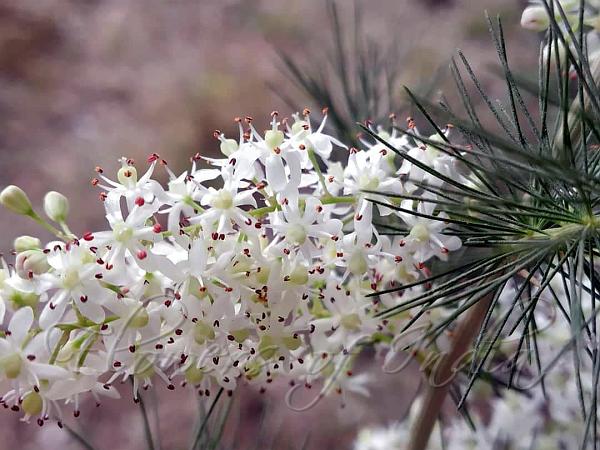|
| West-Himalayan Asparagus |
|

|

|
|
|
|
Photo: |
Botanical name: Asparagus adscendens Family: Asparagaceae (Asparagus family)
Synonyms: Asparagus satawur, Asparagopsis adscendens
Synonyms: Asparagus satawur, Asparagopsis adscendens
West-Himalayan Asparagus is an erect, tall, shrub or
subshrub, with young branches ash grey to white, branchlets grooved.
Spines are about 8-12 mm long, woody. Cladodes many, frequently in
fascicles of 5-20,
thread-like, round, ascending or erect or recurved, 1.0-2.5 cm long.
Flowers are borne in 4-6 cm long raceme. Flower-stalks are up to 6 mm
long, joimted below or in the middle. Flowers are bisexual. Tepals are
3 x 2 mm, blunt. Filaments are up to 2 mm, attached to the base of
perianth. Ovary is 2 x 1 mm, narrow towards the base, style upto 0.6
mm, stigma trilobed, lobes up to 1 mm. Berries are dark red, 4-5 mm in
diameter. Flowering: October-November.
Medicinal uses: The tuber root and rhizomes of
West-Himalayan Asparagus are beneficial in the treatment of infections.
Recently, West-Himalayan Asparagus has become revered as an
aphrodisiac, which has increased its popularity and cultivation in a
number of regions around the world. The plant has also been used in
Ayurveda as an immunity booster and as a general health tonic.
The tuber root and rhizomes of
West-Himalayan Asparagus are beneficial in the treatment of infections.
Recently, West-Himalayan Asparagus has become revered as an
aphrodisiac, which has increased its popularity and cultivation in a
number of regions around the world. The plant has also been used in
Ayurveda as an immunity booster and as a general health tonic.
Medicinal uses:
 The tuber root and rhizomes of
West-Himalayan Asparagus are beneficial in the treatment of infections.
Recently, West-Himalayan Asparagus has become revered as an
aphrodisiac, which has increased its popularity and cultivation in a
number of regions around the world. The plant has also been used in
Ayurveda as an immunity booster and as a general health tonic.
The tuber root and rhizomes of
West-Himalayan Asparagus are beneficial in the treatment of infections.
Recently, West-Himalayan Asparagus has become revered as an
aphrodisiac, which has increased its popularity and cultivation in a
number of regions around the world. The plant has also been used in
Ayurveda as an immunity booster and as a general health tonic. | Identification credit: Anil Thakur | Photographed in Rajouri, J&K & Solan, Himachal Pradesh. |
• Is this flower misidentified? If yes,